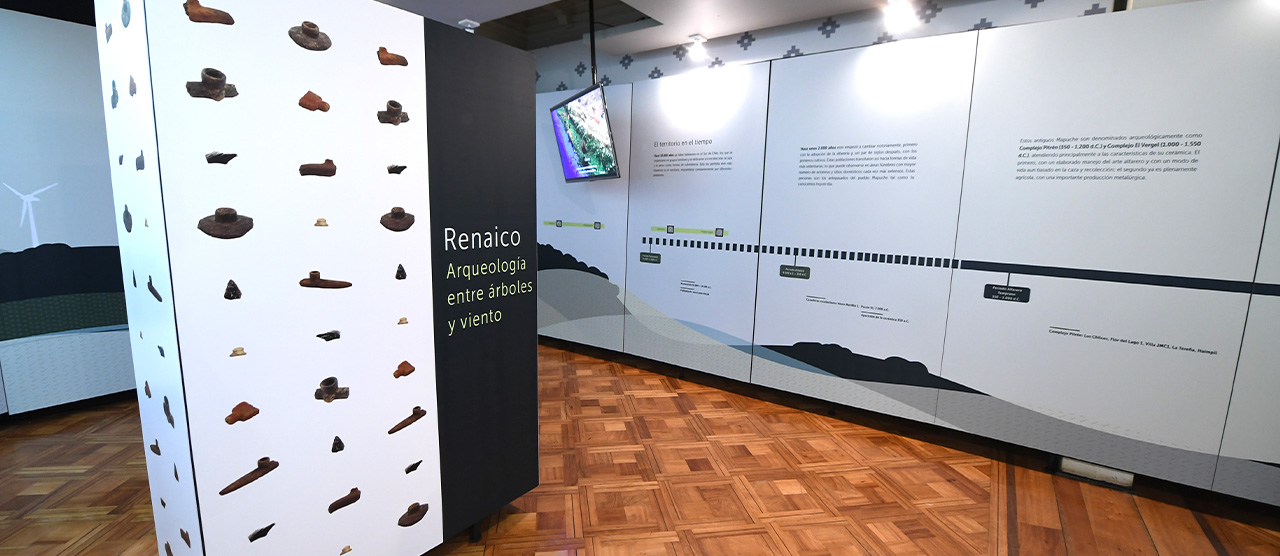
- The "Renaico Archaeology between Trees and Wind" exhibition developed by the Pontificia Universidad Católica's Anthropology Department, Enel Green Power's Environmental team, and the Regional Museum of La Araucanía includes the collection of lithic and ceramic archaeological remains recovered in the vicinity of the Renaico wind farm, during the process of developing the project's baseline and in excavations carried out between 2020 and 2022.
Temuco, October 19, 2022 - Led by archaeologist and academic from the Pontificia Universidad Catolica's Anthropology Department, Dr. Roberto Campbell, "Archaeology between Trees and Wind" aims to rescue and enhance the value of the Araucanía region's cultural heritage and identity.
The sample is composed mainly of lithic and ceramic remains, among which stand out: Obsidian (stones of volcanic origins); Ceramics, such as fragments of metawue (pots; jugs, and plates); Kütras or Pipes; and also Tembetás (facial adornment), rescued thanks to the excavation campaigns carried out by a team of archaeologists from Pontificia Universidad Católica's Anthropology Department.
Findings include two tembetás, a body ornament worn under the lower lip, the first reported in Araucania. So far, discoveries of such artifacts had not reached that far south, the farthest located in the surroundings of the Maule River.
"As Enel, we are committed to the territories where we operate. For this reason, we understand that promoting activities like this allows us to be participatory actors. Companies like ours can contribute by developing environmentally committed initiatives. We aim to satisfy initial obligations and create projects that contribute to knowledge, integration, and strengthening of communities' cultural identity", said Alex Palma, Manager of Enel's Health, Safety, Environment, and Quality area.
The exhibition concentrates 21 pieces available to be visited by the public at the Araucanía Regional Museum between October 2022 and December 2022, free of charge. The collection includes QR stations for downloading free access information and a website https://descubrearqueologia.cl/.
"There is fascinating and unexplored archaeological material in the northern part of Araucanía. For example, ceramics with incised decoration. We knew similar archeological findings had been reported in the area but never in such quantity and diversity as we found in the wind farm", comments Roberto Campbell, Archaeologist and Academic in UC's Anthropology Department." "During the last excavation campaign carried out in June of this year, we found several fragments of a vessel in a fairly narrow sector, so we could reconstruct the base of the piece, which also had incised decoration. We know this type of decoration existed, but to date, no museum has a complete piece. For the first time, we will have an image of how decorations could have been arranged on these pieces".
The temporary exhibition "Renaico; Archaeology between trees and wind" in its assembly, stands out for the incorporation of audiovisual and sound devices that diversify and enrich the experience; as well as its inclusive nature for blind people, who, along with a tactile device, can access audio descriptions in Spanish and Mapudungún. It is essential to know that developing inclusive assemblies aimed at universal accessibility is part of the Araucanía Regional Museum's curatorial timeline.
During the Museum's three-month exhibition, all access will be open free of charge. Archeology students from the UCT will be on hand to assist visitors. The Museum's educational area manages guided tours and educational workshops related to exhibition content, said Miguel Chapanoff, director of the Araucanía Regional Museum.

